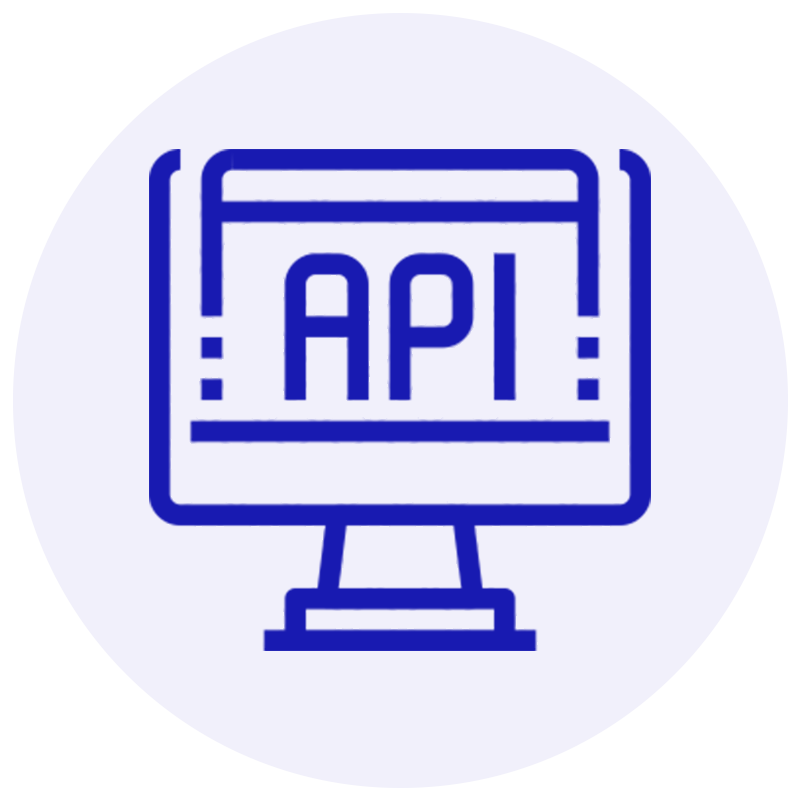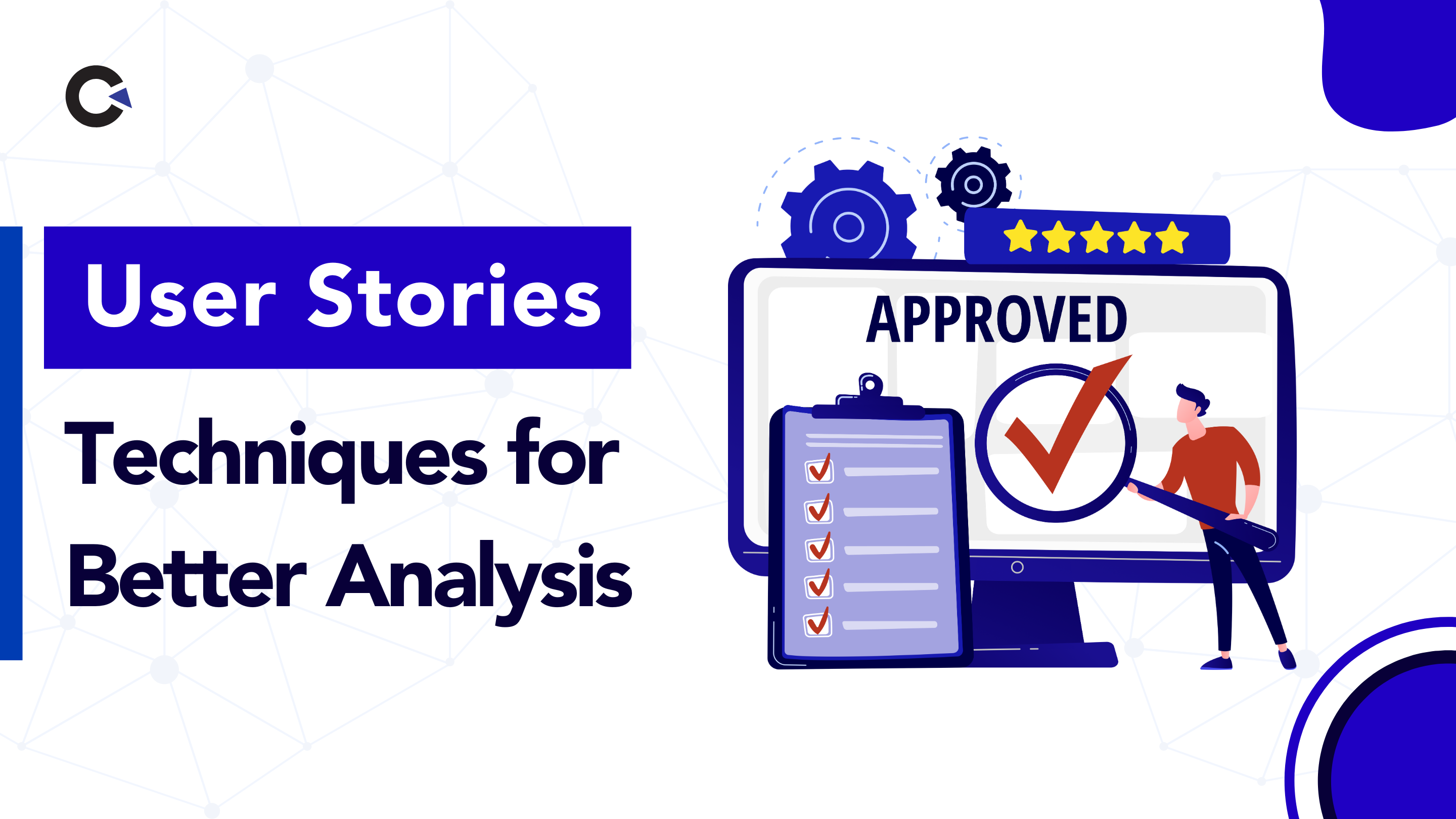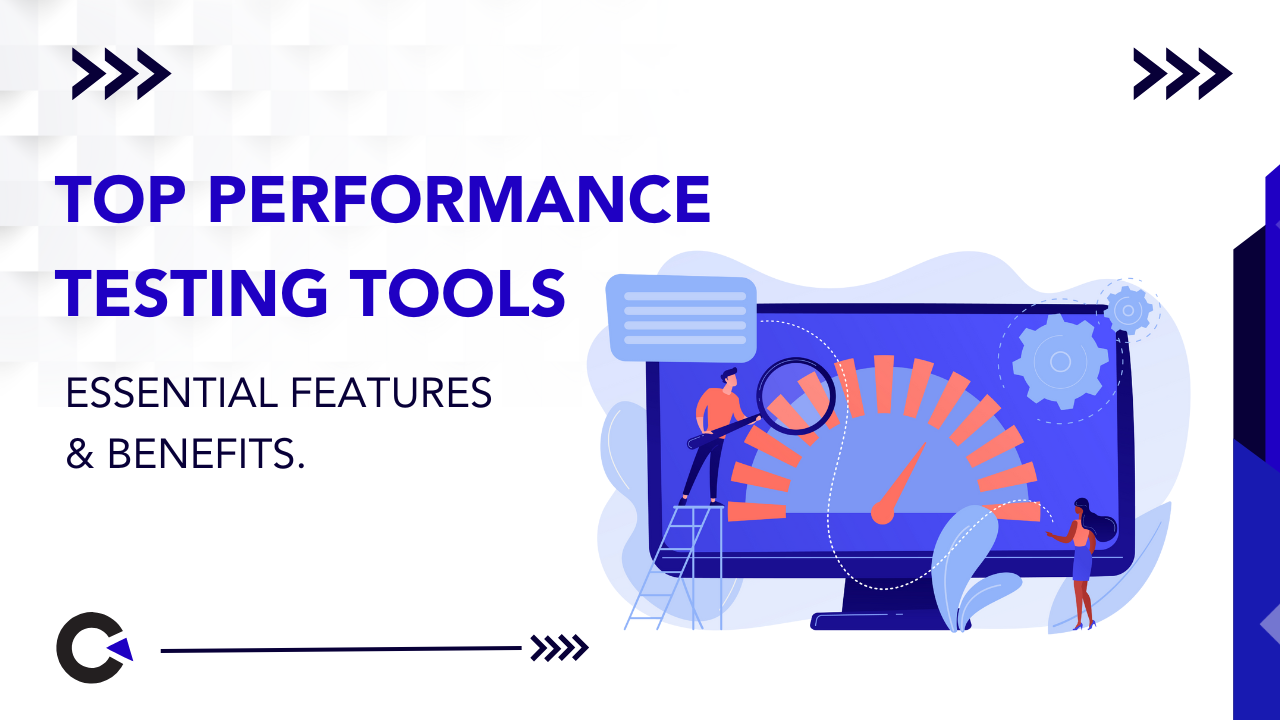
by admin | Mar 17, 2020 | Software Testing, Fixed, Blog |
On this planet everything that is developed should be tested, officially or unofficially. In our rota, we tend to do a lot of testing but we don’t realize because they are part and parcel of daily routines. In a similar profession, the information technology stream adopted the testing domain as one of their power to ensure that the application or software designed working as intended and it serves the purpose.
In this blog we are going to give the knowledge related software testing from the very basic level even a novice will be able to follow.
One must brainstorm themselves to get the motivation of being a software tester. Being an art testing requires some of below skillset.
Intelligence
Out of box thinking
Disciplinary and punctual actions
Planning
Leadership abilities
The mentioned skills were quite common for any profession but when it comes to the point of testing they play an additional role but are mandatory to possess. We keep everything crossed for you to choose to test as your profession, be ready to break the system in a procedural manner and ensure that you are of great help to your team always to launch a perfect flawless product.
Understanding the SDLC
As a pre-requisite, we would strongly recommend one to give yourself a walkthrough on SDLC (software testing life cycle), while going through the below content. A blog can still be understood without SDLC knowledge but it’s recommended as that way you connect the dots while undergoing discovery learning to understand better.
What is software testing?
Software testing a process of identifying the bugs present in the software by validating all possible scenarios that are applicable to the software. In this formal process, we design test cases basis the understanding of the application then executes to deem the correctness of the software
Why is software testing required?
For an illustration, let’s consider that a bank has launched one of its internet banking system applications into production for use without testing. It is evident that customers are going to initiate transactions and apply for various services that are offered by the system.
There is a high probability for the customer-friendly scenarios could fail, which in turn cause the bank to lose its reputation and trust in the market and it’s very expensive for the bank to correct the mistake and re-work on the application
1. Initiated transactions might get failed due to various reason
2. Fund would have not credited at the receiving end
3. Can’t be able to query about the balance?
4. Can’t apply for cheque leaves through the internet banking system.
In the above discussion, it’s a software imagine its software component that performs some physical actions based on the input such as airbag release system in the car, automotive alarms elevators, and lift..etc. failing which can cost lives. So we need to keep the mindset in such a way that, if the application or a working software is not tested we are going to see a huge amount of loss which is difficult to recover from. So we know why testing is essential now, great understanding!!!
Principles of testing
There are a few principles that must be learned which explain the reasoning of testing in all possible views, why wait? Let’s see them quickly
Early testing is beneficial
How early we start to test, that early we can stabilize the system also it’s true that early bugs are cheaper than bugs that are identified late in the business. When we say cheaper if we can identify and fix them early we can avoid doing late regression testing and that as well helps to meet the deadlines. So we should adopt a process that helps us proceed with test activities early in the software life cycle.
Error absence is the fallacy
Though the intention is to test as much as we can and identify all possible bugs, we can guarantee that system if bug-free and 100% flawless. We might have misbehavior seen at a very low level that might not have caught up in our test scope or an unfortunate miss. Despite the principle, we should always ensure that we don’t cover any bug present in customer use cases.
Exhaustive testing can’t be conducted
As part of the testing phase in the software development life cycle, we will conduct various levels and types of testing, but it’s still difficult to cover all the scenarios including positive and negative. Given the timelines for the testing phase we should understand the prioritized edge tests also we need to apply the proper test case techniques to make sure a few test cases will give more coverage.
Pesticide paradox (redundant test case)
We should be continuously reviewing the test cases in order to ensure we have powerful tests and no more duplicates present. If the same tests are being executed again and again we end up identifying no defects. Every time there is an operational change or enhancement in the module, we should build the tests accordingly.
Defect clustering
In any software system, every component has to be treated and tested thoroughly, it could be that most of the defects might be happening in smaller components or from a module which we don’t even think of. We should always focus on the integration pieces and also focus on edge cases as that gives confidence that either boundary are working.
Testing shows the presence of defects
It’s evident that only testing allows us to find defects, how much diligence we possess while testing that much defect rate can be achieved and in turn can help the business to make the application more stable within the nominal time.
Testing is situational dependent
We should keep changing the mindset and the game plan when we are supposed to test different applications or different software. The same strategy will not help us to find the bugs and which will cause so many complexities within the domain. For an illustration, the plan that’s applied for testing a banking-related application may not be useful to test the retail application or insurance application as the requirements and usage are significantly varying.
Software testing life cycle
STLC is a part of SDLC, it’s one of the phases which is executed after completion of development. It’s essential to understand the phases involved in the testing life cycle as that helps us apply the right testing approach. The steps involved in STLC are
Requirement analysis understanding
In this phase, the goal is to analyze the requirements thoroughly to understand the functionality. Any clarification that would be required should be clarified by discussing with the business analysts or the subject matter experts.
Test plan
Once the requirements are understood we should plan for proper testing. We should also define the scope as what comes into the scope and what can’t be. We should also plan the number of resources that would be required also the timelines.
Test case design
Basis the understanding the test case design should be commenced. By following the proper test case development techniques also keeping the type of test in scope we should have the test cases designed. Since the tests designed are going to be executed for finding the defects. Hence proper understanding of the design techniques are needed.
Test data preparation
Test data plays an important role in the execution front. Based on the test data the test execution flow changes, hence apparently we can believe that test data has the ability to drive the test case. We should identify possible combinations of negative and positive scenarios. Test data plays a major role in automation as well, in a pure data-driven or hybrid framework, we can execute the same test with different sets of inputs than writing them as a separate test case. Test data can be maintained in Database or in excel spreadsheet or in any other known form.
Test execution
Once the designing of the test cases and identification of test data is done we need to execute the test cases. Any underlying bugs present in the system can possibly be found in this phase. Due diligence is required while executing the tests as we need to catch up with minor cosmetic bugs as well. Every execution report should be shared with all the stakeholders for their reference and also help with understanding the progress of the test
Test closure
As a test closure activity we will share the final results observed during the execution phase in a detailed format. We will put in graphs, bar charts and presentations so that the higher management can actually understand the status better. Also, the sign-off documents, test risk assessments, and test completion reports are being circulated to get the approval from all business stakeholders.
Test case development techniques
While writing the test cases it’s essential to adopt the techniques to be smart enough also to ensure the coverage with a minimum set of test cases as possible. If the techniques are not followed we end up writing invalid tests also test cases might appear as redundant ones.
Given the two major classifications of testing, we have respective test case techniques designed as well
White box testing techniques
As discussed above it’s a test designed or executed on the structure or design of an application and proper understanding of the code and system is a must.
Statement coverage
Let’s consider a developer is conducting a unit testing, the developer must have a thorough understanding of what that module or component should do? Also, the developer must aware of the code that has been written. Predominantly with the help of this technique, we try to get rid of any unreachable code that’s available in the system. Ideally, the statement coverage is equal to the number of statements being written.
Eg.
Main(){
If(a>0&&b>0){
If(a>b){
Print is bigger;
Else
Print b is bigger;
}
Else{
Print error message saying, negative values are not allowed;
}
}
The statement coverage for the above program is 9, as there are 9 statements.
Decision coverage
The decision coverage mechanism of a white box testing technique ensures that we make proper conditional calls and don’t miss any edge cases. The decision coverage is equal to the number of decisions we have in the system.
Eg:
Main(){
If(a>0&&b>0){
If(a>b){
Print is bigger;
Else
Print b is bigger;
}
Else{
Print error message saying, negative values are not allowed;
}
}
In the above snippet we are making two decisions as to whether or not both the given numbers are non-negative integers then considering a decision as which number is bigger
So the decision coverage for the snippet is equaled to 2
Path coverage
Path coverage ensure that how many use cases and flows can be derived based on the given inputs. Also, we need to ensure that all possible paths are covered to ensure that the system is not open to breaking in any scenario. This can be understood by drawing some UML, flow chart diagrams.
Black box testing techniques
As we already discussed above that black box is a manual validation and test cases are mainly focused to test the functional validation. These techniques will help us to do some permutations and combinations and identify the test cases based on the edge cases or doing some partitioning
Boundary value analysis
In this technique based on the condition, the boundary values such one immediate left and one immediate right boundary values are tested to ensure the state transition is happening properly on the conditional edge.
Eg lets consider that a person whose age is 18 or above only can vote and below age group, people can’t cast their vote.
In order to test this condition we will understand the deciding factor age as “18” as it’s mentioned then identify one value just below 17 and one above 19 as boundary values to test that critical conditional logic.
Equivalence partitioning
This is another technique, which will help us to avoid the number of test cases but gives more coverage in this testing. In this technique based on the condition, we will partition the negative and positive slots and then pick one of those values to test. The lore is that, if the test case is behaving as expected for one value it is understood rest other values would be passed from the same slot.
Eg: let’s consider the same example as above that person with 18 or above can vote and rest can’t
We will identify three partitions as
Age- 0<=17- negative slot
Age- 18= positive slot
Age- 19 to any greater value- positive slot
We will pick any one test data from each classification then with the help of 3 test cases all the scenarios can be covered.
Decision tables
When we have multiple combinations of inputs to test, if we choose to write test cases for all the values it becomes an overhead. Then forming a table with all the conditions and actions put in would help better to identify the cases.
Eg: let’s consider a scenario of withdrawing money from the automated teller machine.
The machine will dispense money only when
Cond-1 user put incorrect passcode
Cond-2 withdrawal money should be lesser or equal to the savings balance.
Action / Goal: Withdraw money from the teller machine.
The above requirement can be converted into a decision table as,

State transition testing
In this technique we need to understand the state flow of the use case then come up with a design flow diagram. This flow can help us derive how many flows and how many are positive and negative. In order to do this, we must have proper knowledge of the application.
Use case testing
Use case tests are designed to be more customer-specific test. The test case is written in the form of a user guide where the steps are written in a procedural format. This gives more insight on the test procedure as it talks about the actors, events n pre and post conditions in specific.
Eg: let’s consider a login scenario into an application
Actor
Actor is the person who performs that events
Pre-condition
Actor should own a good network provision
Actor should be on the login page to be able to enter credentials
Events
Steps are addressed as events, the events involved in this step are
Enter the username and password
Click on the login button
Alternatives
This says what other actions can be possible when actor on that page.
The actor can look for help link or actor can try signing up if the account is not created yet.
Exceptions
These are the problems that user might encounter during the execution of events
Application might be throwing an error upon entering the credentials
After the clicking the login button, occurrence of any HTTP error
Post- actions
These are the subsequent actions executed after the completion of events.
Logging out from the application
Performing any business functionality with in the application
Conclusion
We reckon it’s a vague discussion, but every piece in this is important to be a competitive and distinguished tester. Adopting these fundamentals will help us test the applications with due diligence and with enhanced coverage. How much its the fact that the principles have to be understood, in the same fashion we must apply the sense to determine what technique to be used and when. I keep everything crossed for every reader to be a successful tester.
Thanks for reading!!! More we know more we grow.

by admin | Mar 11, 2020 | Software Testing, Fixed, Blog |
Software testers are considered to be the gate-keeper of the quality and hence are very vital to the success of any software. Still, this ever-evolving career option Software Testing is surrounded by many myths and misconceptions. Let us unveil the reality behind them:
MYTH: Fighting against the bugs is the only Bull’s Eye
REALITY: To most of us, even the tasks of a software tester are ambiguous. Some of us say the core task is to make the software bug-free but it is not at all the truth. Software testers have a huge list of functions to be performed, including checking the interoperability, inter-browser acceptance, smooth working, security against malicious codes, and fighting against the bugs. So making the software bug-free is just one of the tasks. There is indeed a bigger picture beyond this little point.
Also, even if the software is fully protected against the bugs, there may be other issues hampering the smooth functioning of the software viz, server crashes in the period of huge traffic on the site or some browsers not supporting the software, some users are unable to access or transact through it, and much more
MYTH: Software Testing is inferior to Software Development
REALITY: This myth is too harsh to be real for software testers who actually put in so much effort day and night to ensure the quality of the software. So in reality, both the professions go complementary. Developers are not able to launch their software into the market until it is duly tested by the testers to get certain about the security and QA of the software. So the developers are dependent on testers.
Also, vice versa is true. The testers have to work according to the codes and programs used by the developers during the development stage. The testers have to gather information about bottlenecks in the software, which can only be known by its creators. So the testers are dependent on developers.
Hence, none of them are inferior or superior to each other.
MYTH: Software Testing requires no specialized qualification or less expertise
REALITY: This is one of the biggest misconceptions that we think that any person from an engineering background can join a team of QA Analysts. In order to fully understand the system and debug the root cause of any issue, testers need to know about the underlying database structure and the different technologies used.
Apart from that some testing activities like white box testing, automated testing, security testing, etc requires specialized programming language and/or a particular tool’s expertise.
MYTH: Automation can eliminate manual testing requirement
REALITY: This is a misconception not only in the context of software testing but all technology-related fields. We believe that with the increase in automation, human intervention will decrease but this is not the case. Even automated techniques require a human application and continuous monitoring by expert personnel. So automation testing can never substitute manual testing techniques completely, rather the integration of both in the right proportion will bring greater results.
MYTH:Testing does not contribute to value addition
REALITY: It is not necessary that value addition happens only when some new software is designed. Testing the software also contributes to the cycle of value addition by enhancing its quality and improving its durability.
Without ideal testing, launching a new software can prove to be worthless, in that case even the primary value addition will become a zero. So testing is secondary but immensely affects the value addition of the primary activities like software designing so it is a part of value addition itself. So testing is never an extra expense, it bears fruits if done in the right way.
MYTH: Testing may lead to delay in launching new software
REALITY: It is true that testing is time-consuming but the time spent on it never goes worthless. Testing should be considered as a part of development only instead of considering it as an extra activity. Thus, time utilized in testing or QA is counted in the process of designing and development itself. Moreover, automated techniques have reduced the wastage of time in lengthy manual methods so we can not conclude that testing leads to any delay in launching if new software.
MYTH: Software once tested is perfect forever
REALITY: Software testing is a continuous process. As and when there are changes in any coding or programming of the software, testing is required to risk-proof those changes, even if they are minor. With increasing users of your site, there may emerge new issues related to the performance of software, so testing is required at every step.
It is not only done once before it is launched, rather the process continues even after years of its initial designing and introduction in the market. The malicious codes or worms can come up any time to damage your software, so it is a whole-time job.
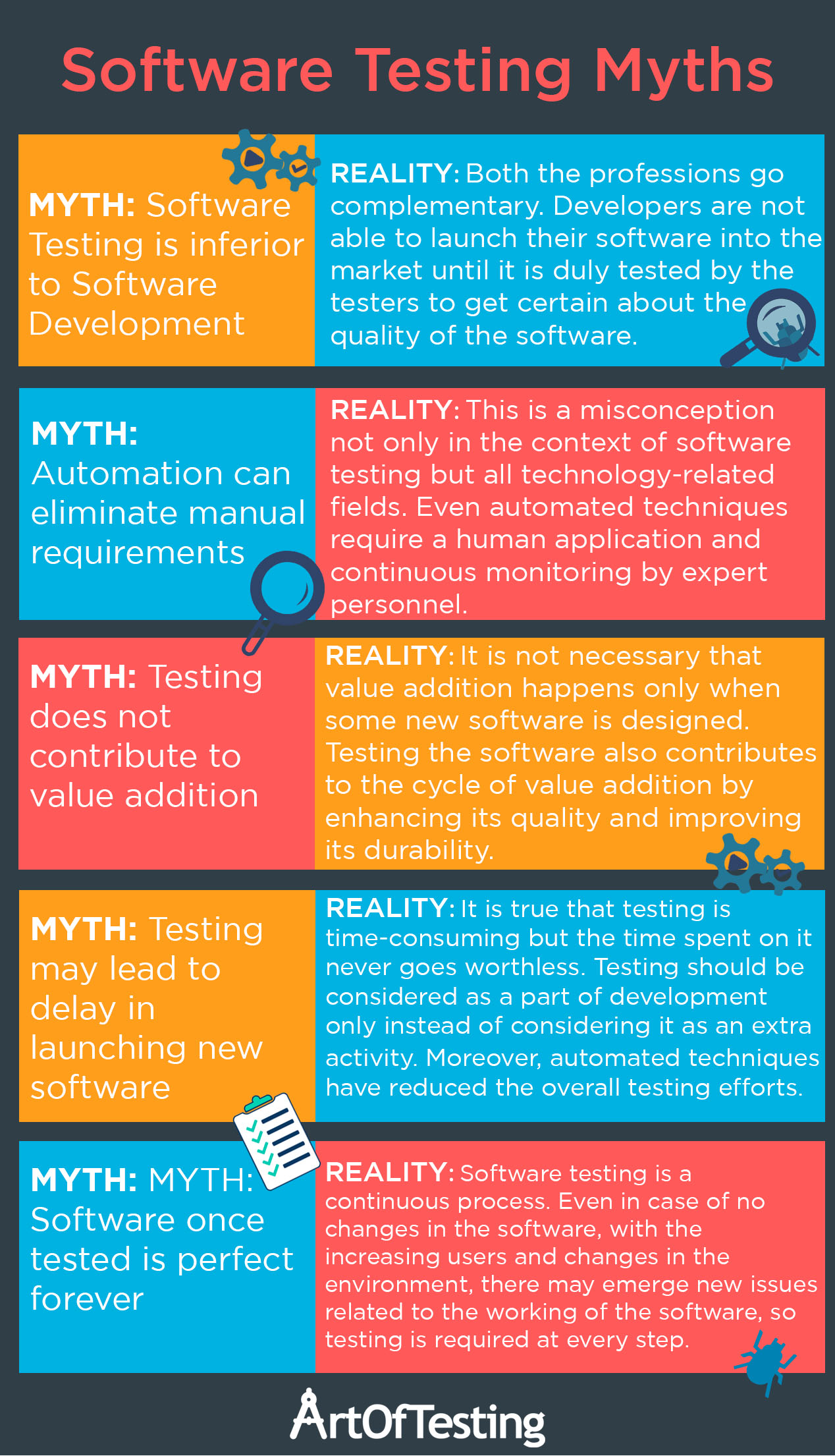
Conclusion
If any of these myths were stopping you to choose software testing as a career, so clear your minds and be confident about your choice. And if you are already a software tester and you had wrong notions about your tasks, I hope this article will show you the true picture and help you work with more efficiency.
Author Bio
Kuldeep Rana is the founder of ArtOfTesting, a software testing tutorial blog. He is a QA professional with a demonstrated history of working in the e-commerce, education and technology domain. He is skilled in test automation, performance testing, big data, and CI-CD.

by admin | Mar 4, 2020 | Software Testing, Fixed, Blog |
In this blog we are going to discuss what test strategy is all about, why test strategy is required when we would require a test strategy document and finally about how to write Test strategy document
What is a Test Strategy
A Test strategy is a static document that describes how the testing activity will be done. This is like a handbook to stakeholders which describes the test approach that we undertake, how we manage risk as well as how we do testing and what all levels of testing along with entry and exit criteria of each activity. This will be a generic document that the testing team would refer to prepare their test plan for every project.
Test strategy act as a guidelines/plan at the global Organization/Business Unit level whereas Test plan will be specific to project and always we should ensure that we are not deviating from what we commit in Test strategy
Why Test Strategy is required
It gives an Organization a standard approach about how Quality is ensured in the SDLC. When there is any typical risk involved in a program, how to mitigate those risk and how can those risks be handled. When every project adopt to the same standard, quality improvement will be witnessed across the Organization and hence Test strategy is important
When do we need a Test Strategy
Below could be some of the circumstances which would require Test Strategy.
When an Organization is forming a separate QA wing
When there is a change in QA Organization from normal QA model to TCoE / QCoE where the operating model and structure is changed
When QA leadership changes who comes with different perception
When Organization is adopting different tool approach for Automation / Performance etc
Contents of Test Strategy
Below are the contents of Test Strategy document
1) Brief Introduction about programs covered in this Strategy
2) Testing Scope and Objective
3) Test Planning / Timeline
4) TEM Strategy
5) TDM Strategy
6) Performance Strategy
7) Automation Strategy
8) Release and Configuration Management
9) Test schedule, cycles, and reporting
10) Risk and Mitigation
11) Assumptions
Brief Introduction about programs covered in this Strategy
This section covers the overall scope this Test strategy is going to be covered with. Important engagement and programs which will run based on this Test strategy.
Testing Scope and Objective
This section describes the following
What will be the different levels of testing conducted like Integration, System, E2E, etc
The process of review and approval of each stage
Roles and Responsibility
Defect process and procedure till final Test sign off
Test Planning and Timeline
This section covers in-brief the following
What are the programs going to be executed
What is the timeline that each program is going to constitute
What will be the infrastructure and tooling needs to support this program
Different Environment that will be used
TEM Strategy
Prior section describes the overall requirement and this section describes in detail about the Test Environment Strategy and covers the following
1) How to book Environment for project purpose including booking 3rd party Environment
2) Assess to Environment to users for project requirement
3) Environment integration and stability management
4) Test data refresh co-ordination
5) Post release Environment validation
6) Support and co-ordination requirement
TDM Strategy
Similar to Environment, different project test teams would require different data requirement and some would need to mock up live data. This section in TDM strategy would provide the below information
What are the forms to be filled and agreement to be in place to serve this data need
What type of data to be loaded and when it will be available
Who will be the point of contact for each program
If any 3rd party Vendor support is required, this would describe in detail of that
Performance Strategy
Based on various programs and its schedules listed in the prior section, performance strategy would describe how Performance Testing requirements would be fulfilled and what their tool strategy, license model is and team availability. If the team also does Performance Engineering, it would describe in detail about how it is performed
It cover details about Requirement phase (How NFR requirement will be gathered from stakeholders, Proof of concept procedure, how critical scenarios are defined.), Testing phase (How testable scripts are created, how data setup is done), Analysis and Recommendation (How performance issues are reported, sign off procedure)
Automation Testing Strategy
Similar to Performance Strategy, Automation strategy would describe how requirements are defined, tool strategy, license model, etc and also elaborate how the Automation team conducts feasibility approach till defining framework, developing scripts till execution and Continuous Testing if it is in-scope
Release and Configuration Management
This section describe the following areas of Release and configuration management
Overall release and configuration strategy
QA deployment and release calendar
How different Test assets are loaded and tracked
Co-ordination of QA Deployment
How QA audit is conducted
How production deployment is co-ordinated by the QA team
Change Management for any CR post-release is managed
Test schedule, cycles and reporting
This section details out about each program, its schedules, Test timeline, Test cycles and how reporting will be carried out.
Risk and Mitigation
This section describes overall risk management and risk mitigation process along with how it will be tracked and reported.
It also classifies various risk levels like Project level and program level risk and describes how it will be handled during the execution phase
Assumption and Dependencies
During Test strategy development the timeline of program etc are in a predictive stage as it could be for a period of 1-5 years and hence there is going to be a lot of assumption which should be listed in this section. Also, there are different teams which Testing team has to co-ordinate with like TEM, TDM, vendors, etc which needs to be called out in advance in the assumption and dependencies as any change in Project-level / Program level scope will have an adverse impact and it has to be called out in strategy as assumption and dependencies
How to write Test Strategy document
For now we have covered about what Test strategy is all about, why it is important and looked in detail about the contents of the Test strategy, it is now easier to define how to write better Test strategy document.
Before writing Test strategy we need to collect few information which is listed below:
List of programs that need to be handled in this stream
Programs and its releases objective and basic requirement it is going to meet
Criteria for Environment and Data management requirement
Timeline of each releases and it’s key stakeholders
Third party integration and vendor management details
Information about Test type and release frequency
Tool requirements/procurement process understanding
Basic assumption and dependency with outside QA Organization
This information will be collected by Program Test Manager after discussing with Key stakeholders of the program.
The collected information has to be discussed internally within the QA team Managers and assign responsibility to detail out further requirements to refine the Test Strategy.
If the program is going to be from the QA Transformation perspective, then further information has to be collected on the key QA levers that are going to run the program run differently.
After identifying the key levers, assign the responsibility of each lever to a dedicated person so that Strategy can be further fine-tuned and can be circulated to wider group.

by admin | Mar 24, 2020 | Software Testing, Fixed, Blog |
In this blog it is assumed that we know the importance of testing thus, for now, it’s time to understand what are all the different software testing types that are available and when to use what. A proper test plan must have documentation and the timelines of each type of testing alongside the description. The three major classifications based on the mode of execution are:
White/clear box testing
White box testing talks about the testing conducted at a technical and very low level. This testing is to validate the structure, design, and implementation of the system. Writing the unit tests, integration tests also designing scripts at the system level is part of this classification.
This type of testing is done by understanding the source code. The objective of this testing is to validate all part of the source code like decision branch, loop and statement are verified.
Unit testing which is done by developer is a part of White box testing.
Black box testing
This is solely the functional validation done by the manual functional testing. These tests are designed by understanding the requirement then execute them manually then verify the results. The test coverage techniques used in this process are to ensure the test coverage is high with not taking overhead of documenting too many repetitive tests.
The testers who do this type of testing will not conduct code review / assess the code coverage/statements etc. They don’t have any understanding of what code is written. But they are executed and functionally validated to ensure that Application does what is expected out of it.
Grey box testing
This is a blended mix of both white box as well as the black box testing. In this, we try to cover both the strategies. A tester who does this Grey box testing has partial knowledge of code. Predominantly they execute a function written with different functions input and assess the quality of function.
The black box testing can further be divided into three major types
Functional testing
In this testing type, our focus is to validate the functionality by understanding the requirement. This is a simulation of a user test. The intention of this test is to determine whether the product built-in right fashion.
This functional testing is further classified into a few types they are
Smoke testing
This is a build verification test, once the development gives build its essential to execute the most common scenarios that are needed to confirm the given revision of build is a good candidate for further testing.
Sanity testing
Sanity test is a prioritized test, if at all the timelines given and the amount of testing to be done are unparalleled then we pick the edge cases and the most priority test cases to deem the sanity of a build. Ideally speaking this is a subset of regression testing.
Adhoc testing
This is a functional test without any concrete plan, based on the experience we have developed on the application front we execute the scenarios.
Non-functional testing
In this testing alongside validating the functionality we mainly focus on testing the performance of an application by subjecting that to a specific load as determined. It’s not just limited to the performance we validate so many other characteristics of applications. The types of Non-Functional testing done are
Performance testing
It helps to assess the stability of software under a certain workload
Volume testing
It helps to test the software with a huge volume of data and assess the response of the Software to huge volume.
Load testing
When a huge load of data is given to a program, how it handles the load. Huge Spike is given in a short span of time and understands how it handles.
Security testing
When some vulnerability is injected into the system under test, how it handles such condition. It is to validate if it is able to recover from such vulnerability. It is predominantly used to test the application whether it is free from any threat or risk.
Localization testing
When we declare an application has multi-lingual support, we need to perform Localization testing to ensure whether the application is able to display pages/content in the current local language. Here all the links and contents are validated to ensure that content is designed to specific to that local language.
Compatibility testing
When we publish software, we declare on what all different hardware, Operating system, network, browsers, devices, etc it will support. This will be a part of the release notes. We need to ensure sunder such conditions this software supports without any issue. Testing done to validate on different hardware, Operating system, devices, etc are called compatibility testing.
Endurance testing / Soak Testing
A specific load is given to the Application for a prolonged period of time to assess system performance/behavior.
Regression testing
Regression testing is conducted to ensure, the code fixes have not caused any new breakage of the application in some other place. In this test instead of running the failed case alone, we run all the test cases that were passed before to confirm the presence or absence of defects. Regression testing helps us to find the stability of the applications as we pass by the timelines.
This test should be run with an agreed frequency to ensure that the addition of new functionality, integration of any other new component and any bug fixes have not affected any other existing system functionalities.
Levels of software testing
In the process of the software development life cycle, we have corresponding testing phase involved. The ideology is to conduct testing at different levels to ensure the functionality and we don’t deviate from the process. When we discuss the levels of testing, we don’t specifically limit the scope to the testing phase, rather we discuss the kind of testing done at every phase of SDLC and here it could be the fact that many teams intervention might be observed. Following are the different levels of testing that we conduct in SDLC process.
Unit testing
This is the first low-level test that’s conducted by the developer. In this testing, we test only the particular component for its working condition also the developer has to ensure the proper statement, decision and path coverage was done with reference to the requirement built. If unit tests are failed developer has to look into the problem and fix them immediately as no further testing can be unless this is completed successfully.
Integration testing
This is the next phase of unit testing, in this level of testing we focus on the integration that is established between the modules and check whether the services give proper requests and responses. This is done by both testing team development team. Integration tests, in general, are kind of API tests as the whole system not ready yet. We have two more subcategories of these tests based on the unavailability of a specific master or slave module.
Top down approach
This approach is adopted when any slave or listener component in the application is not available for testing but we need to conduct testing to meet the deadline. In this case whatever the module that’s not available yet would get replaced by a stub. The stub is a simulating system, which acts as the regular component that we should have got ideally in place.
Bottom down approach
It’s the reciprocal process of the above-mentioned one. If at all the master component or service is not ready to test and we have to test the other components then the master component would get replaced by a dummy driver system. Although the driver is not a real system we will give the power to drive the other components as per the need.
System testing
This testing is done once the whole system is made available, the focus of the test is to validate within the system. All possible scenarios and customer use cases must be thoroughly tested. This is the most prioritized official test as we learn a lot of bugs and also this is the level where we see the system turns out to be a reliable one.
System integration testing
This level of testing is conducted when the complete end to end connectivity of the application with all possible external downstream/ upstream systems was connected. This is the real time test where the test replicates the usage of the customer flow once the application gets launched.
User acceptance testing
Use acceptance test is conducted by the customer or product owner. This is the final verification test that’s performed before the application goes live. This test builds confidence in the business as to whether or not the reliability criteria that’s set was met and application is good to be launched. This is again classified into two sorts based on the environment where it’s conducted. The rationale behind doing this test at two sites is to isolate any external parameters that are actually intervening in the results we observe. This will rather help to pin down certain problems and root cause the problems.
Alpha testing
This test is done at the actual test team sites to understand the results. All observations are made a note to compare against with other types of the UAT testing.
Beta testing
This test is done at the customer sight, after the execution the results are compared to understand and conclude
1. If the same problems have occurred.
2. The problems observed at one’s sight are due to the improper or slow infrastructure and not of the application.
Conclusion:
The above listed are types of testing that are used predominantly used in most of the Organization. There are some special testing conducted for specific needs like to test Gaming Application, different techniques, and testing types will be used. But this blog extensively covers the testing type which is for testing the most common type of Applications which covers 80% of the Organization requirement. Thanks for reading this blog.

by admin | Apr 10, 2020 | Software Testing, Fixed, Blog |
Functional Testing is a type of software testing which is performed to validate the basic functionality of the Software Application against functional requirements. Software is developed based on business requirement and Functional Testing helps and assures that Software developed is as per the business requirements.
Functional testing comes under black-box testing as functional tester does not bother about how the code is written or conducts code review to validate the code, instead, he executes the software and provide inputs based on business and functional requirement and validates against his expected result to certify the Application.
Functional Testing can be carried out for any software irrespective of Web Application, desktop application, web service or a stored procedure. Be it any type of Technology, the objective is to validate the functionality of the system under test is as per the business / functional requirement.
Why Functional Testing:
Why Functional Testing leads to a question of why testing?
Testing is done to ensure that the application works as expected. When an application is delivered without testing, then there is no assurance/guarantee that the application will function as expected. More than 60% of testing efforts go to Functional Testing effort. Remaining efforts would be a part of Non-Functional Testing like Performance, usability, security, etc.
Without Functional Testing we cannot conclude software does the operation as expected and hence Functional Testing is as important as software being developed by the development team.
Aspects of Functional Testing
Below are the key aspects of Functional Testing:
1. Testing based on Functional Requirement
2. Testing based on Business Process
Testing based on Functional Requirement
This Testing is based on the nature of the application functionality. Whenever a build is provided based on User stories / Functional Specification / Business Requirement document, we carry out various types of testing to prove it function as expected.
Before delivering the Application to Functional Testing team, developers do testing and it is called Unit Testing. Once developers complete the Unit Testing Application build is delivered to the testing team for Functional Testing.
Before we conduct a thorough Functional Testing we perform Smoke and Sanity Testing to ensure that build is stable and can be carried out for further testing. When a build is failed in smoke and sanity, that means the build has a serious flaw and developer has to further work on it.
Once Smoke and Sanity Testing is passed, Integration, System Testing and System Integration Testing is performed to certify the Application under test.
Testing based on the Business process:
When we say Business process from Functional Testing point of view, it is the End to End flow of business-critical functionality. Example) if an Application deals with Payment processing, then the business process would be testing the Payment setup until payment initiation until successful / exception criteria.
We could define a critical end to end business process considering positive and negative flow and testing these critical business areas. From this aspect, we could also perform risk-based testing based on the testing timeline and the number of business process areas.
Entry and Exit criteria of Functional Testing
Below are the key Entry criteria for Functional Testing:
Requirements must be fully frozen with clearly defined expected outcome (Requirements could come in the form of Business Requirement / Functional Specification document or User Stories)
Development should be completed
Build must be unit tested and completely signed off by the development team
Test Strategy and Test plan should be completed and should be signed off by stakeholders
Test data should be available for execution
Below are the key Exit criteria for Functional Testing:
Test cases should be prepared with complete coverage on requirements
Test cases should be reviewed and signed off by the Business team
Test cases must be executed and Severeity1 and 2 defects should be closed by Testing team
Functional Testing Strategies:
Before performing functional testing, below pointers/strategy would help to manage the test effectively:
Validate if the requirements are clear
1. To test effectively requirements should be clear with the clearly defined input and output criteria’s
2. If the requirements are not clear, enter into series of discussion with Business team, development team and project stakeholders beforehand and take steps to crystallize the requirement.
3. Even after series of discussion, if requirements are not clear come up with the In-scope and out of scope and keep requirements whichever are not clear in out of scope.
4. Raise a project-level risk and get into agreement with project stakeholders.
Assess and come up with proper Functional Plan
1. Based on the requirement clarity and project scope come up with Functional Test plan covering the scope of testing, type of testing to be conducted, Test schedule, resource requirement, risk management procedure, etc
2. Once the Functional Test plan is prepared, get it signed off from project stakeholders
Identify the Test Schedule and Execution Timeline
1. Based on the project plan, identify time allotted for Testing phase
2. Calculate the execution timeline
3. Come up with Risk-based Testing approach for better functional coverage
4. If the timeline is less, execute P1, P2 Test cases and get into agreement with Stakeholders
Resource fulfillment and Automation assessment
1. Based on the project schedule and Test schedule, assess and do feasibility of Automation and validate the benefits expected out of automation
2. Identify the right resource requirement if automation can be implemented
Proper Defect Management
1. Assign proper defect Manager / Coordinator for conducting defect triage calls
2. Escalate for Sev1 and Sev2 priority fixing with development counterparts
3. Extend timelines or come up with alternate plans based on Environment/delay in defect fixes
4. Assign to testers based on defect fix by the development team
5. Review of defect retesting and closure
Proper Test Completion Report
1. When Functional Testing is completed, Test Completion report has to be prepared
2. While preparing Completion report, ensure in-scope and out of scope is declared properly
3. Update inference from Functional Testing and any defects are open/deferred update it properly in the closure report
4. Update what went well, what not went well with a reason along with improvement areas as well to be updated
Key Metrics that we report on Functional Testing
Functional Testing metrics can be classified based on the Test Phases:
Test Design Metrics:
Total Test Coverage
Automation Coverage
Test Design productivity (Manual and Automation)
Test Execution Metrics:
Test Execution productivity (Manual and Automation)
Test Execution Coverage
Error Discovery Rate
Test cases Passed / Failed / Blocked / Deferred
Defect Metrics:
Defect Leakage
Defect Removal Efficiency
Defect Density
Defect Fix Rate
Key Business Outcome
Present the Functional Testing Outcome post every release during retrospection/release closure discussion.
Invite key stakeholders and provide an update to key parties on overall Functional Testing outcome and benefits through Functional Testing activity. Since the QA team is much closer to the Business team in-terms of business requirements understanding, present how much of defects have been raised with criticality and how many defects converted to release / functional enhancement will be the key thing to be discussed. This will be an interesting story to Business team.

by admin | Apr 5, 2020 | Software Testing, Fixed, Blog |
Welcome to Codoid blogs once again, in this blog we are going to see about software testing metrics. Below are the topics we will cover in this blog.
What is a Metric
Why Metric is required
Types of Metrics in Testing
Testing Metrics in Detail
What is a Metric
As per standard definition, A Metric is a quantifiable measure to track the progress of certain areas which we want to constantly monitor and report.
Metric is used to predict something which we wanted to measure and we can set a benchmark for it so that we can compare it with a certain interval of time. Example) Speed which we travel can be a metric and we can keep a benchmark as 48 kmph. We can constantly measure every day or every week and we can compare against our benchmark.
Why Metric is required:
1. Metric will help us to give us a prediction on how are we performing.
2. It gives us direction on how we perform release after release to ensure we are constantly improving. If there is a decline in performance, we can take corrective steps to improve that particular factor
3. It helps us to uncover potential risks in our project.
(Example, We are targeting to go live on a date assuming 10 days of Test Execution with 20 TC / Day productivity, Let’s assume for consecutive 5 days productivity is only 10 TC / Day, this could eventually delay our execution by 5 more days and will delay the release. It is a potential risk to the project. On tracking this execution productivity on a day to day basis during execution timeline, will tap the project in our control, we could take action on 2nd day itself and keep the project on track.)
4. Improves the Test Coverage and Automation coverage.
5. It helps in continuous process improvement, once we become mature in a way of tracking, we could add a few more metrics and helps in coming up with continuous improvement in our project delivery.
6. It helps to plan for release in a better way. As with each and every release, if we track metrics, we could use predictions and with the lessons learned from previous releases, we can come up with better planning.
7. It overall improves the Cost, Quality and Time in delivering the project.
Types of Metrics in Testing
Based on the STLC phases, we can define metrics for each phase of Testing. Let us see them in detail in this section.
STLC Phases are:
Requirement Analysis
Test Planning
Test Design
Test Execution
Test Closure
And for each of these phases we have multiple metrics to track.
Testing Metrics in Detail
Requirement Analysis
Requirement Quality:
Requirement Quality defines the correctness/accuracy of the requirement.

IRQ – is the quality of Individual requirements which signifies whether the requirement is valid (value 1) or invalid (value 0). It can be measured in percentage as well.
Correctness of Requirement:
This metrics helps us to determine if the requirement is correct/valid/is not a duplicate.

IRC will be 1, if it is a valid requirement, else it will be 0
Requirement Creep:
This metric helps to understand how much percentage of requirements added post requirement gathering phase.

Test Planning
Metrics in Test Planning is used to arrive at how effective testing is carried out. We track and tap the control of the project by taking various measurements during Test Design and Test Execution activities. Below are the few measurement criteria that help in the effective Test Planning
Resource Requirement Vs Fulfilment
Effort burnt VS Progress
Cost Spent Vs Work Done
Cost Spent Vs Requirement Coverage
Overhead Cost
Team productivity
Test Design
Test design is the most important phase in Software Testing. There are a lot of metrics that can be generated in Test Design phase and will be useful to management for tracking purpose.
Some of the Metrics with formula are given below:
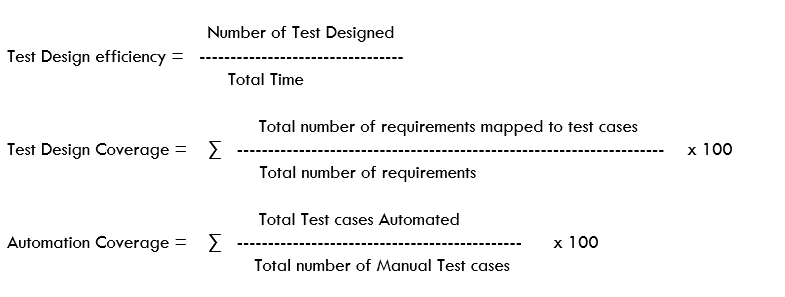
Test Execution
Below are few standard metrics used in Test Execution phase:
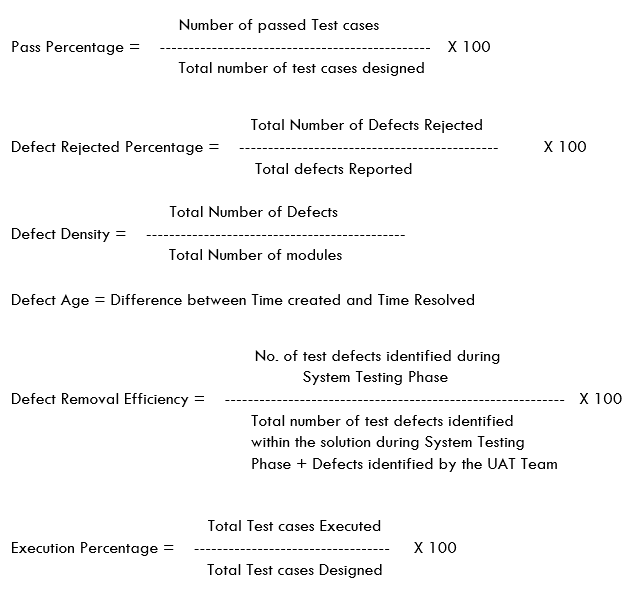
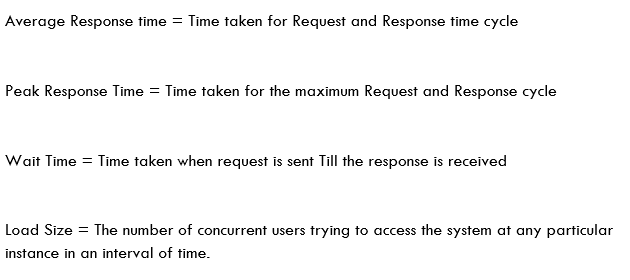
Test Closure:
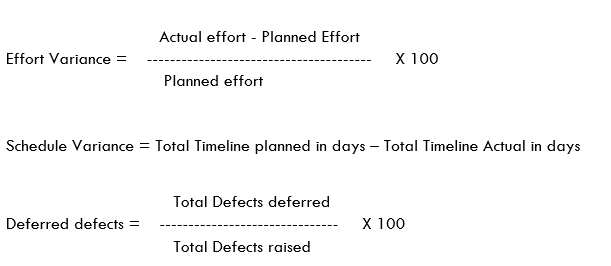
Defects by priority and severity will be tracked as a part of Test closure report
Conclusion:
Testing Metrics are helping us to track our progress and improve our delivery quality in a better way. There are so many metrics available to track the progress and Test Management tools nowadays are better equipped with various features to track these metrics and it also has various customization mechanism to track custom metrics rather than following standard metrics, we should first finalize KPI and Metrics for our measuring the performance and utilize these tools features to satisfy our requirement.



